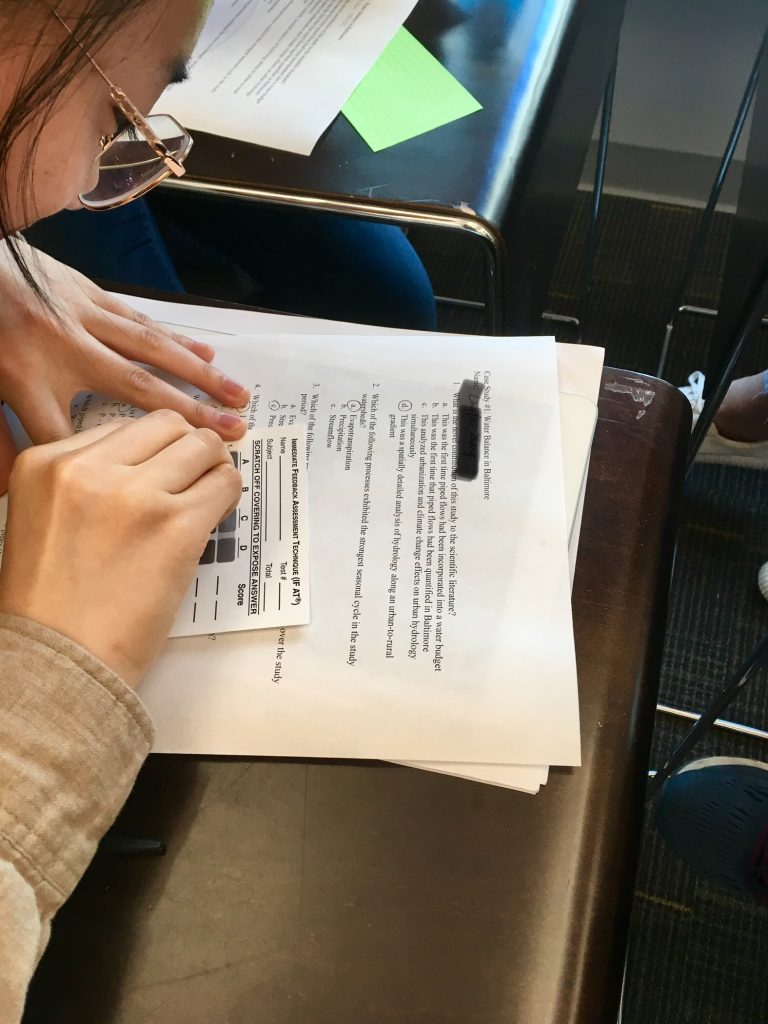Guest blog post by Kateri Salk, Visiting Assistant Professor, Nicholas School of the Environment
As part of the Active Learning Fellows program, I learned about a technique called team-based learning and implemented it in my classroom the following semester. Team-based learning is a style of active and cooperative learning that draws upon several benefits that these approaches offer: individual accountability, interdependence, increased retention of material, and development of higher-order thinking skills (i.e., moving beyond comprehension into analysis, evaluation, and synthesis). I am always looking for ways to meaningfully integrate teamwork into my classroom, so I was excited to try this approach. Team-based learning sessions quickly became some of my favorite days this semester, and my students were big fans as well. Below, I outline the principles of team-based learning, how I implemented it in my class, and the outcomes I observed.

The team-based learning process consists of four phases. More information can be found on the team-based learning website.
- Preparation before class. In my case, the students read a journal article (or a few) on the topic.
- Individual assessment (individual readiness assurance testing; IRAT). Students individually take a quiz on the material, wherein each question has a correct answer. This individual assessment makes up part of the grade, ensuring individual accountability, but is often weighted less heavily than the team assessment.
- Team assessment (team readiness assurance testing; TRAT). Each team takes the quiz again, using the insights they have from the individual assessment to come to consensus on an answer. Rather than taking the quiz on paper or online, teams are given scratch-off quizzes that reveal a star if the correct answer is chosen. The scratch-offs not only provide instant feedback but are also fun! Teams are given full credit if they choose the correct answer on the first try and half credit if they choose the correct answer on the second try.
- Application activity: Several questions are posed, during which teams must come to consensus on their answer choice. Unlike the IRAT and TRAT, these questions do not have a correct answer, and the students must justify why they think a given option is the best choice. Teams reveal their choices by holding up a colored index card and then discuss as a whole class. Ideally, teams will choose different answers and then can debate their choices.
Although traditional team-based learning is meant to be implemented for the entire course, I tried using the team-based learning framework for just three class periods. A common recommendation when trying out new active learning activities is to start small, incorporating changes in manageable increments. I dedicate a few days each semester to in-depth case studies, which was typically a group discussion activity that lent itself well to the transition to team-based learning. I was able to try out the approach in small increments and consider expanding in future semesters.

I noticed several positive impacts of team-based learning in my classroom:
- Intense discussion. The students wanted to be sure they understood concepts correctly, so there was a lot of discussion even around straightforward questions. Students seemed more inclined than usual to seek specific pieces of evidence to support their choices.
- Consensus building. Even though the instructions did not specifically specify it, students sought consensus rather than a “majority rules” choice. When there was disagreement, they worked to understand the source of the disagreement rather than making the loudest argument in favor of their position. When students were unsure of how to cast their vote, they sought to be convinced by specific arguments and evidence rather than going with the flow.
- Everyone has a voice. During the discussion portion of the class, I required that every person from each team be designated the spokesperson for one question. Students felt responsible to convey their team’s conversation accurately but could develop their response in a comfortable, small group space before reporting out. Students seemed eager to share the rationale for their team’s decision.
- Classroom community. My students developed a very supportive and tight-knit classroom environment this semester, in no small part due to the team-based learning activities. Case studies were consistently mentioned as a favorite activity in midterm evaluations, partly because they got to interact with a different set of people than they usually did during lessons. I noticed that the class learned each other’s names and got to know each other much better than in typical semesters. During the discussion section of team-based learning, students acting as the spokesperson were eager to point out when someone on their team had come up with a good idea or to (good naturedly) challenge a student from a different team on their rationale.
I made a few adjustments to the team-based learning approach to better fit it to my course. For the IRAT and TRAT, I divided the testing time into “closed book” and “open book” sections, so students could test their comprehension of each article and then strategically look for evidence to support their answers. This approach was helpful, as it didn’t force them to completely memorize the content of scientific journal articles yet did require them to prioritize their time. Adding this tweak to the quiz process emulated scientific practices: scientists look up information but need to find it quickly and have the conceptual background to know where to look.
